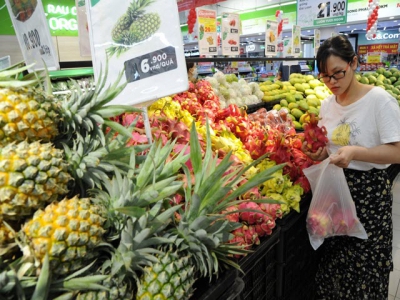Vietnamese growers reap the fruit of their labors

In the first half of 2020, while vegetable and fruit exports to China decreased sharply, those to other markets increased. Growers and traders are being advised to improve product processing and importers’ satisfaction in order to expand markets in the post-corona period.
Plummeting Chinese market
Data compiled by the General Department of Vietnam Customs show that in the first half of 2020, Vietnam exported vegetables and fruits worth US$1.76 billion, down 13.6 percent compared to the same period in 2019.
While fruit and vegetable exports to China decreased 29.3 percent compared to the same period in 2019, those to other markets increased sharply. Specifically, fruit and vegetable exports to the Republic of Korea (RoK) reached US$81.7 million, up 25.2 percent, those to Thailand were US$79.4 million, up 234.2 percent, those to Japan hit US$68.2 million, up 13.1 percent, and those to Chinese Taipei reached US$43 million, up 86.8 percent.
The Ministry of Industry and Trade’s Agency of Foreign Trade said despite the increases, fruit and vegetable exports to non-Chinese markets accounted for only 40.6 percent of the country’s total.
Thailand is a world-leading fruit and vegetable exporter and processor, so it has a large demand for fruit and vegetable imports as material for export production.
In June 2020, Vietnam’s fresh lychees were exported to Singapore and Japan, opening up opportunities for Vietnam to export not only lychee but also many other fresh vegetables and fruits.
Fresh produce exports
Dr. Nguyen Van Hoa, Deputy Director of the Southern Fruit Research Institute (SOFRI), assessed that Vietnam is by no means inferior to Thailand and China in terms of fresh fruit quality, but is weaker in terms of fruit and vegetable production, post-harvest treatment and marketing. Thailand has left Vietnam far behind it in terms of produce (including fruit) research, processing and preservation, Hoa said. Short lifetimes, high air transport cost, and problematic preservation are challenging Vietnamese fruit and vegetable businesses. It is very important to develop farm produce processing, while enterprises need state assistance in accessing better air transport fares.
Ta Duc Minh, Vietnamese Trade Counselor in Japan, said Vietnamese lychees are more competitive than Chinese ones in terms of quality and are highly welcomed in Japan. Vietnamese lychee exporters need to apply better post-harvest preservation technology and diversify modes of trade promotion to integrate Vietnamese lychees deeper into the Japanese market, he said.
Vietnam is looking for new fresh fruit importers including India. Vietnamese Ambassador to India Pham Sanh Chau said India is a relatively easy market with low technical standards, and this is an opportunity for Vietnamese businesses.
The EU has a stable demand for fresh fruits and vegetables, accounting for 45 percent of the global trade in vegetables and fruits. New and tropical fruits attract EU consumers, providing opportunities for exporters from countries like Vietnam.
According to the Vietnam Trade Office in the Netherlands, with large scale and seasonal demand, the EU has become an attractive market for suppliers in developing countries. Vietnamese fruit and vegetable exporters need to meet importers’ product quality standards and other requirements if they are to increase exports to EU markets.
Associate Professor, Dr. Dao Ngoc Tien, Lecturer of International Commerce, Foreign Trade University:
Geographical indications and origin information are crucial for vegetable and fruit exports, especially when Vietnam has joined new generation free trade agreement (FTAs), as they add value to Vietnamese vegetables and fruits.
Có thể bạn quan tâm
Phần mềm

Phối trộn thức ăn chăn nuôi

Pha dung dịch thủy canh

Định mức cho tôm ăn

Phối trộn phân bón NPK

Xác định tỷ lệ tôm sống

Chuyển đổi đơn vị phân bón

Xác định công suất sục khí

Chuyển đổi đơn vị tôm

Tính diện tích nhà kính

Tính thể tích ao hồ



 First Vietnamese batch of rice to export to…
First Vietnamese batch of rice to export to…  Today farmers use internet to market and sell…
Today farmers use internet to market and sell…